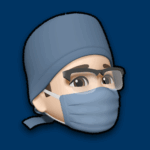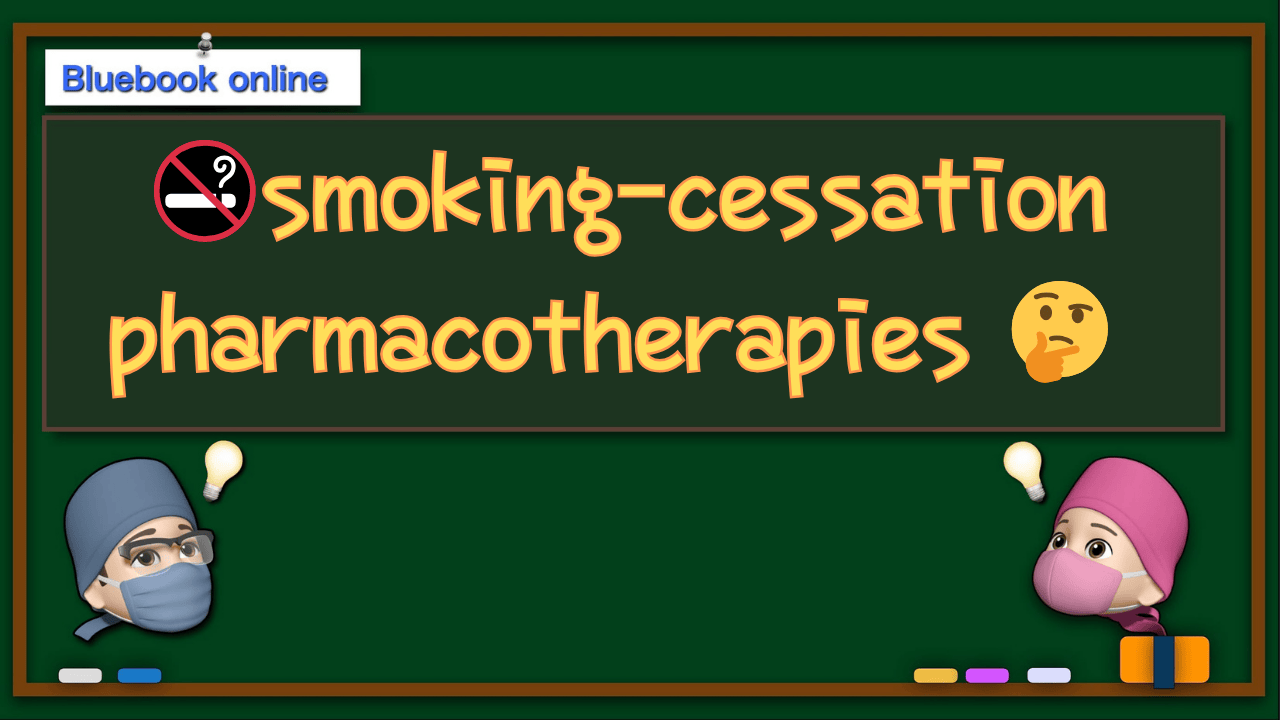👉👉 🇺🇸 All Posts 🇬🇧 / 🇯🇵 記事一覧 🇯🇵 👈👈
♦️Introduction: Why perioperative smoking intervention matters
 まっすー
まっすーDoctor, this patient has only one week until surgery and wants to quit smoking — what should we do about medications?



Good question. Preoperative smoking cessation reduces postoperative complications, but which medication to use depends on the waiting time until surgery, cardiovascular risk, whether the patient drives or does hazardous work, and any history of epilepsy or psychiatric disease. Let’s sort out nicotine replacement therapy (NRT), varenicline, and bupropion, and point out exam-friendly items.
Tobacco smoking increases the risk of postoperative pulmonary complications, impaired wound healing, and cardiovascular events in many studies.
Data suggest that quitting before surgery reduces postoperative complications; therefore, when possible, stopping smoking ≥4 weeks before surgery is commonly recommended. Even with short waiting times or urgent surgery, short-term interventions can still be beneficial.
- Perioperative smoking-cessation interventions may reduce postoperative complications (e.g., pulmonary complications, surgical-site infection). Aim for smoking cessation at least 4 weeks before surgery when possible.
- Varenicline: Several randomized trials and patient-level meta-analyses report that it does not significantly increase major adverse cardiovascular events (MACE). Note, however, warnings about neuropsychiatric adverse effects and precautions for patients doing driving/operation tasks.
- Nicotine patch (NRT): High-quality evidence that transdermal nicotine by itself inevitably delays wound healing is lacking; nonetheless, in high-risk cardiac patients or in specialties sensitive to microcirculatory changes, individualized judgement is needed.
- Bupropion: Lowers seizure threshold — avoid or use with caution in patients with epilepsy or other seizure risk. (Bupropion is not marketed in Japan.)


♦️ What smoking-cessation pharmacotherapies are available?
The main drugs used in the perioperative period are the following three:
- Nicotine replacement therapy (NRT) — transdermal patch, gum, inhaler (note: some formulations are not approved in Japan).
- Varenicline (varenicline) — partial agonist/antagonist at nicotinic α4β2 receptors. But Varenicline is currently subject to a worldwide distribution suspension.
- Bupropion (bupropion) — norepinephrine/dopamine reuptake inhibitor with antidepressant properties; lowers seizure threshold. Not marketed in Japan.
Because each drug differs in mechanism, dosing schedule, and adverse-event profile, selection must consider patient background (cardiac disease, psychiatric disease, epilepsy, driving/occupational issues) and time until surgery.
🔷 Nicotine patch & gum — practical points
✅ Mechanism & dosing
Transdermal patch supplies a steady dose of nicotine systemically. Patch strength is typically adjusted according to the patient’s baseline smoking amount.
✅ Advantages
While onset of effect is not instantaneous, the patch provides stable nicotine delivery and helps blunt acute withdrawal symptoms; it is convenient in the perioperative setting.
✅ Adverse effects & cautions
Local skin irritation and sleep disturbance are common.
Nicotine causes sympathetic stimulation, may increase heart rate and blood pressure, and can affect vascular tone and endothelial function. However, high-quality, consistent evidence that short-term NRT causes clinically important deterioration in cardiovascular outcomes is lacking.
Clinical teams nonetheless often exercise caution for patients with ischemic heart disease, and for some high-risk procedures (e.g., certain plastic-surgical cases) opinions lean toward extra caution.
Smoking itself clearly impairs wound healing. The evidence that transdermal nicotine alone reliably delays wound healing is limited and inconsistent. Therefore, statements that “the nicotine patch inevitably delays wound healing” are not well supported by high-quality evidence. Still, in specialties sensitive to microcirculation (e.g., reconstructive surgery), clinicians may be cautious.
✅ Practical note
When waiting time allows, many clinicians start patch therapy several weeks preop and continue until surgery. For patients with ischemic heart disease, the decision whether to continue the patch on the day of surgery is typically made by the perioperative team.
🔷 Varenicline — practical points
Note: currently there are supply issues — in 2021 some products were voluntarily recalled due to detection of nitrosamine contaminants; as of October 2025 some shipments have not resumed (see manufacturer statements).
✅ Mechanism & dosing
Varenicline is an α4β2 nicotinic receptor partial agonist. The usual schedule is a titration (week 1 low dose → increase), and full clinical effect often requires several weeks, although some perioperative studies show benefit with shorter exposure.
✅ Efficacy
Multiple RCTs and meta-analyses show high smoking-cessation rates with varenicline; perioperative RCTs have reported improved cessation rates.
✅ Safety & cautions
There have been reports of neuropsychiatric adverse events (depression, suicidal ideation), leading to label warnings and cautionary statements.
Regarding cardiovascular safety, several patient-level meta-analyses and analyses that include RCT data have concluded that varenicline does not significantly increase major cardiovascular events — many reviewers therefore judge that varenicline does not increase cardiovascular events overall.
Nevertheless, because individual patients may develop neuropsychiatric symptoms, it is advisable to counsel patients who drive or operate heavy machinery and consider work limitations if symptoms occur.
If waiting time is sufficient, varenicline is an effective option and may be started preoperatively and continued through the perioperative period. For very short waiting times, initiation just before surgery is not usually recommended because full effect requires time — although some studies report cessation benefits even with short interventions. Clinical judgment is required.
🔷 Bupropion — practical points
✅ Mechanism & dosing
Bupropion, an antidepressant that inhibits norepinephrine and dopamine reuptake, is used as a smoking-cessation aid; several days to weeks of initiation are required.
✅ Adverse effects & contraindications
Bupropion lowers the seizure threshold. It is contraindicated (or requires caution) in patients with epilepsy, those undergoing alcohol or benzodiazepine withdrawal, and in some drug combinations. Perioperatively, be mindful of interactions with anesthetic agents and psychotropic drugs.
Bupropion is less commonly chosen as a first-line perioperative option compared with varenicline or NRT but may be selected based on patient preference and history.
6. Perioperative practical decision flow (summary)
- Waiting time ≥4 weeks → behavioral support + pharmacotherapy; varenicline is a strong option; consider combination strategies.
- Short waiting time (e.g., 1–2 weeks) → prioritize NRT (patch) to control withdrawal; varenicline usually takes longer to show full effect.
- High-risk ischemic heart disease patients → evaluate on a case-by-case basis; day-of-surgery continuation of NRT is decided by the perioperative team.
- Driving or hazardous work → counsel patients on possible neuropsychiatric or alertness effects (esp. varenicline); restrict duties if necessary.
📝 Summary:Take-Home Points
- When possible, intervene with smoking cessation before surgery (ideal: ≥4 weeks).
- Varenicline generally is not associated with increased cardiovascular events in pooled patient-level analyses, but counsel for neuropsychiatric risks and driving/occupational safety; note current supply/recall status.
- Evidence that nicotine patches always delay wound healing is lacking; nonetheless, caution is warranted in individual high-risk cases.
- Avoid bupropion in patients with seizure risk.
- Varenicline is currently subject to a worldwide distribution suspension.
📚 References & Further reading
- Wong J, Abrishami A, Yang Y, Zaki A, Friedman Z, Selby P, Chapman KR, Chung F. A perioperative smoking-cessation intervention with varenicline: a double-blind, randomized, placebo-controlled trial. Anesthesiology. 2012;117(4):755-764. doi:10.1097/ALN.0b013e3182698b42. PMID: 22890119.
- Ware JH, VanSpall HGC, O’Donnell MJ, et al. Cardiovascular safety of varenicline: patient-level meta-analysis of randomized, blinded, placebo-controlled trials. Am J Ther. 2013;20(3):235-246. doi:10.1097/MJT.0b013e31827ab4a3. PMID: 23615317.
- Benowitz NL, Pipe A, West R, Hays JT, Tonstad S, McRae TD, et al. Cardiovascular Safety of Varenicline, Bupropion, and Nicotine Patch in Smokers: A Randomized Clinical Trial. JAMA Intern Med. 2018;178(5):622-631. doi:10.1001/jamainternmed.2018.0397. PMID: 29630702.
- Sørensen LT, Karlsmark T, Gottrup F. Wound healing and infection in surgery: the clinical impact of smoking and smoking cessation — a systematic review and meta-analysis. JAMA Surg. 2012;147(4):373-383. doi:10.1001/archsurg.2012.5. PMID: 22508567.
- Hartmann-Boyce J, Chepkin SC, Ye W, Bullen C, Lancaster T. Nicotine replacement therapy versus control for smoking cessation. Cochrane Database Syst Rev. 2018;5(5):CD000146. doi:10.1002/14651858.CD000146.pub5. PMID: 29852054.
- Regulatory safety communications: FDA / EMA / PMDA statements regarding varenicline (Chantix / Champix) label updates and safety information.

コメントを投稿するにはログインしてください。